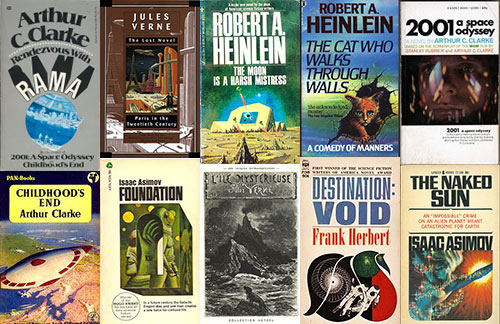… ten favorite sci-fi books …

OK … lots of repeat authors on this list, but I’m a sucker for classic science fiction. These are my ten favorite novels that I could come up with off the top of my head.
In no particular order …
The Moon is a Harsh Mistress, Robert A. Heinlein (1966)
Take Heinlein’s characters from Stranger in a Strange Land, swap their roles around and write them into a matriarchal anarchist society on the moon. Throw in some true American sentiment and a dash of liberty fever. The only thing missing is a sentient supercomputer … oh wait … got that one too!
Rendezvous with Rama, Arthur C. Clarke (1972)
One of the more suspenseful books I’ve ever read. An enormous rotating cylinder (twenty miles long) speeds into our solar system for unknown reasons. A team is sent to explore the craft and discover its purpose. This one really needs to happen in real life so that I can volunteer for the exploration team.
Destination: Void, Frank Herbert (1966)
Clones Clones Clones! These silly clones think they are headed toward another solar system about a spaceship carrying thousands of frozen colonists. Wait until they find out that the disembodied brain that is driving their ship is programed to malfunction and force them to problem solve a solution or die in the cold depths of space. Too bad it’s all a simulation … and one of them knows the truth.
Paris in the 20th Century, Jules Verne (1863)
Jules Verne’s lost dystopian future novel set in 1960. It has all the classic Verne touches … melodrama … strange inventions … romance … strange inventions … The tone is spot on even after 140 years. Technology has taken over the world and art has no place anymore. It’s kind of like our world now, except that technology has taken over the world … and flooded the world with bad art.
Foundation, Isaac Asimov (1951)
The Foundation Trilogy, along with its extended family of novels, is my favorite book series. It is the raw material from which the Star Wars saga was made. A crumbling Galactic Empire … rebellious trade federations … a mysterious sect of psychics that can manipulate human thought. Any book written in the 1950’s that equates particle dynamics to predicting human history must be good.
Childhoods End, Arthur C. Clarke (1953)
This creepy epic tells the tale of how our civilization would cope with being introduced to a more advanced society. Mysterious “Overlords” appear from another world to usher in an era of world peace. The story spans decades … so it’s not much of a character piece. It does create an interesting climate of fear and suspicion in which the human race reacts quite inappropriately to their benefactors. Just why do the Karellans never show themselves? If you truly want to know … don’t read the f’ing Wikipedia page … read the BOOK!
The Cat Who Walked Through Walls, Robert A. Heinlein (1985)
Heinlein’s back with half the cast of every book he’s ever written. I don’t know if old age set in and he just went wonkers … at some point Heinlein decided to start mixing up all his characters and stories with the premise that authors are godlike beings that have the power to create worlds. Most of his later work falls into this category. Awesome. And then there’s that little kitten …
2001: A Space Odyssey, Arthur C. Clarke (1968)
Easily a classic of both cinema and science fiction literature. In the book the spacecraft Discovery is headed to Saturn. In the film, it’s headed to Jupiter. I think they ditched Saturn because it was too difficult to realistically portray its rings on film. The movie also left out my favorite part of the book … How did David Bowman manage to survive the remaining trip to the rendezvous point after HAL killed the crew?
The Mysterious Island, Jules Verne (1874)
This one isn’t very sci-fi (until the end). If you have ever seen the 1960’s movie that was supposedly based on the book … PLEASE ERASE IT FROM YOUR MIND. There are no giant crabs. No beautiful girls running from big killer bees. It does have loads of information for those planning to be stranded on a desert island. If you can look past the completely dated mindset of the characters, you just might survive being Lost on a Mysterious Island.
The Naked Sun, Isaac Asimov (1957)
This book covers overpopulation, agoraphobia, underpopulation, robots and psychedelic light shows. The protagonist’s sidekick is a robot that goes on to star in many other Asimov books. Speaking of robots:
Isaac Asimov invented the Three Laws of Robotics. It may sound geeky, but when humans start to create walking talking thinking machines, they will need an ingrained set of logical rules to guide them. After all, we don’t want any Terminators running loose deciding humans are just viruses infecting the Earth right? Thankfully, Asimov worked out the rules for us a loooong time ago. No joke:
The Three Laws of Robotics.
1. A robot may not injure a human being or, through inaction, allow a human being to come to harm.
2. A robot must obey orders given to it by human beings, except where such orders would conflict with the First Law.
3. A robot must protect its own existence as long as such protection does not conflict with the First or Second Law.